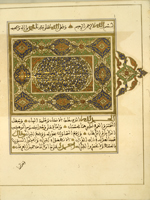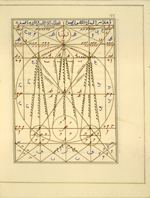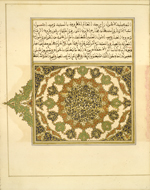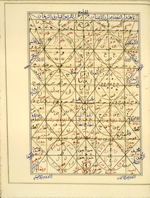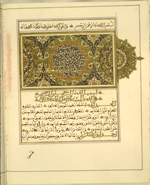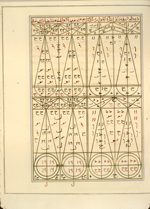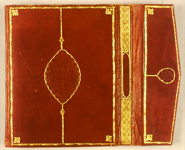Catalogue: Alchemy
-
 Kitāb al-Burhān fī asrār ‘ilm al-mīzān (MS A 7)
Kitāb al-Burhān fī asrār ‘ilm al-mīzān (MS A 7) - (The Book of the Proof Regarding the Secrets of the Science of the Balance)
- كتاب البرهان فى اسرار علم الميزان
- by ‘Izz al-Dīn Aydamir ibn ‘Abd Allāh al-Jaldakī (d. 1342/743)
- عز الدين ايدمر ابن عبد الله الجلدكى
This treatise is concerned in large part with the alchemical theory of the 'balance', but it also includes an elaborate classification of animals, plants, and minerals. In essence it is a summary of knowledge up to al-Jaldakī's day, not only in alchemy but also in cosmology, physics, astrology, and numerology.
The copy at NLM, filling seven illuminated volumes, is undated and unsigned. Its illumination, calligraphy, and bookbinding, however, are good examples of manuscripts produced in the scribal workshops of Marrakesh during the second half of the 19th century. For such workshops, see Tim Stanley, 'North Africa. The maintenance of a tradition', in Manijeh Bayani, Anna Contadini, and Tim Stanley, The Decorated Word: Qur'ans of the 17th to 19th centuries [Khalili Collection of Islamic Art, 4] (Oxford: Oxford University Press / London: Azimuth Editions, 1999), pp. 42-5.
Kitāb al-Burhān fī asrār ‘ilm al-mīzān (MS A 7)
Illustrations
The illuminated opening of a copy of the alchemical treatise Kitāb al-Burhān fī asrār ‘ilm al-mīzān (Proof Regarding the Secrets of the Science of the Balance) by al-Jaldakī (d. 1342/743). The undated and unsigned copy was made in Morocco and is typical of products made in the scribal workshops of Marrakesh during the second half of the 19th century.
A schematic diagram in the form of a pan-balance from a copy of the alchemical treatise Kitāb al-Burhān fī asrār ‘ilm al-mīzān (Proof Regarding the Secrets of the Science of the Balance) by al-Jaldakī (d. 1342). The undated and unsigned copy was made in Morocco and is typical of products made in the scribal workshops of Marrakesh during the second half of the 19th century.
The illuminated colophon to the first volume of a seven-volume copy of the alchemical treatise Kitāb al-Burhān fī asrār ‘ilm al-mīzān (Proof Regarding the Secrets of the Science of the Balance) by al-Jaldakī (d. 1342). The undated and unsigned copy was made in Morocco and is typical of products made in the scribal workshops of Marrakesh during the second half of the 19th century.
An elaborate multi-colored table from a copy of the alchemical treatise Kitāb al-Burhān fī asrār ‘ilm al-mīzān (Proof Regarding the Secrets of the Science of the Balance) by al-Jaldakī (d. 1342). The undated and unsigned copy was made in Morocco and is typical of products made in the scribal workshops of Marrakesh during the second half of the 19th century.
The illuminated opening of the fifth volume of a seven-volume copy of the alchemical treatise Kitāb al-Burhān fī asrār ‘ilm al-mīzān (Proof Regarding the Secrets of the Science of the Balance) by al-Jaldakī (d. 1342). The undated and unsigned copy was made in Morocco and is typical of products made in the scribal workshops of Marrakesh during the second half of the 19th century.
A schematic table in the form of a series of pan-balances from a copy of the alchemical treatise Kitāb al-Burhān fī asrār ‘ilm al-mīzān (Proof Regarding the Secrets of the Science of the Balance) by al-Jaldakī (d. 1342). The undated and unsigned copy was made in Morocco and is typical of products made in the scribal workshops of Marrakesh during the second half of the 19th century.
An elaborately decorated diagram from a copy of the alchemical treatise Kitāb al-Burhān fī asrār ‘ilm al-mīzān (Proof Regarding the Secrets of the Science of the Balance) by al-Jaldakī (d. 1342). The undated and unsigned copy was made in Morocco and is typical of products made in the scribal workshops of Marrakesh during the second half of the 19th century.
The seven volumes comprising this manuscript are bound in identical bindings of red leather over pasteboards with envelope flaps. On each cover this is a deeply-impressed mandorla panel stamp whose inner field is filled with interlaced vines with flower-buds. The mandorla has a double gold-painted outline of shallow scallops; the points come together at the base of a bouquet of three small flowers from which a balustrade line extends to the frame. The frame is a tooled and gold-painted band of twisted double lines, and at each corner there is a stamped and gold-painted flower-bud. A similar frame occurs on the envelope flap, with a much smaller ovoid panel stamp. The fore-edge flap has a gold-stamped diaper pattern either side of an elongated cartouche.
Physical Description
Arabic. 1247 leaves (in seven volumes: 170, 201, 174, 155, 175, 219, 153 folios). Dimensions 26.7 x 21.2 (text area 17.3 x 13.8) cm; 19 lines per page. The title appears in the illuminated opening (fol. 1b) and in the illuminated colophon (fol. 170a) of first volume. The author's name is given in the illuminated opening (vol. 1, fol. 1b).
The copy is undated and unsigned. It was quite certainly made in Morocco in the second half of the 19th century. Its illumination, calligraphy, and bookbinding, however, are good examples of manuscripts produced in the scribal workshops of Marrakesh during the second half of the 19th century.
All seven volumes were transcribed and illuminated by the same unnamed craftsmen, using the same paper type throughout.
The text is written in a large Maghribi script using black ink, with significant words in gold (outlined in black) or in red, green or blue. Throughout the volumes the text is written within frames of blue, black, and gold fillets. These frames are then set within larger frames formed of two fine black lines with gold between. There are catchwords. The folios have been numbered in each volume with Western numerals on the verso of each folio rather than on the first side of the leaf.
Each volume has an illuminated opening, and all but volumes 5 and 7 have illuminated colophons. See volume 1, fol. 1b and fol. 170a; volume 2, fols. 1b and 201a; volume 3, fols. 1b and 174b; volume 4, fols. 1b and 155b; volume 5, fol. 1b; volume 6, fols. 1b and 219b; and volume 7, fol. 1b. The original pink guard sheets opposite these illuminated openings and closings have been removed.
The text is illustrated with numerous tables and diagrams in the same colors (gold, black, red, green, and blue). See vol. 1, fols.148b, 149b, 153a, 155b and 168a; volume 2, fols. 72b, 97b, 115a, 123a, and 173a; vol. 3, fols. 27a and 30b; vol. 5, fols. 26a and 29b; vol. 7, fols. 52a, 53a, 54a, 55a, 56b, 59a, 72a, 121a (a horoscope), and 132b.
There are modern marginalia in volume 5.
The ivory, lightly glossed, paper has neither laid lines nor chain lines; it is watermarked (EXTRA SUPER). There is slight soiling through thumbing.
Binding
The seven volumes comprising this manuscript are bound in identical bindings of red leather over pasteboards with envelope flaps. On each cover this is a deeply-impressed mandorla panel stamp whose inner field is filled with interlaced vines with flower-buds. The mandorla has a double gold-painted outline of shallow scallops; the points come together at the base of a bouquet of three small flowers from which a balustrade line extends to the frame. The frame is a tooled and gold-painted band of twisted double lines, and at each corner there is a stamped and gold-painted flower-bud. A similar frame occurs on the envelope flap, with a much smaller ovoid panel stamp. The fore-edge flap has a gold-stamped diaper pattern either side of an elongated cartouche. The fore-edge flap lining is red leather; the envelope flap lining is white paper. There are modern pastedowns and endpapers.
Provenance
The volume was purchased in 1941 by the Army Medical Library from A. S. Yahuda (ELS Nos. 1631, 1632, 1633, 1634, 1635, 1636, 1637).
References
Schullian/Sommer, Cat. of incun. & MSS., entry A 7, p. 299.
NLM Microfilm Reel: FILM 48-111 and FILM 48-112

